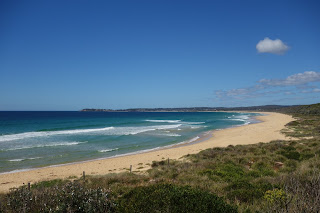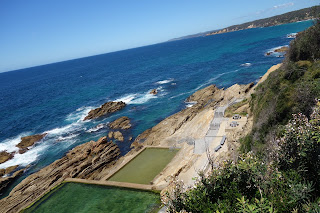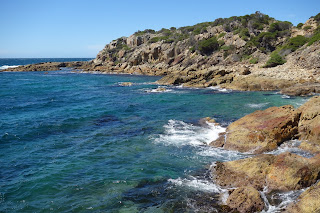Another beautiful, hot, sunny day today (sorry to everyone reading this where it's snowing) and I was treated to a lovely, chauffeured, tour of some of the coastal towns and highlights south of Narooma, and then inland a bit on the way home so that we completed a big circle.
Our first stop was at Wallaga Lake - just after we crossed the little bridge across the lake. Wallaga Lake was formed when two river valleys were drowned some 6000 - 10 000 years ago, and today it is home to more than 200 bird species.
Back on the coast again and our next stop was at Camel Rock Beach. Yes, I'm sure these photos are probably starting to look a bit repetitive, but this really and truly is spectacular coastline.
Camel Rock Beach is aptly named - this is the rock formation at the north end of the beach.
Bermagui is the next town as I travelled south and I didn't actually go to the beach area there, but we did stop and had a great coffee at a place called Mister Jones (for any Australians reading this who might be in the area, I highly recommend this place). A port at Bermagui was established in the 1830s and with the continental shelf just 20 kms away, here is where it is at its closest point to the Australian mainland.
Just south of Bermagui was a bit of a lookout and a chance for me to scramble around a bit on the rocks.
The Blue Pool is a very unique swimming location at Bermagui. Once called the Blue Hole, it's a tidal pool and was once only half its present size. 'Renovations' were done in the 1940s and the current Blue Pool is what you see today.
And not only is the Blue Pool beautiful - but so is the coastline around there as well (no surprises I'm sure).
Continuing south, our next stop was Tathra which is likely most famous for its steamer wharf (the little building you can see in this photo). The old steamer wharf was first built 1862 and stayed in use until 1954. Today it is classified by the National Trust. It is the only open-sea timber wharf on Australia's east coast surviving from the coastal steamer trade era.
Not surprisingly, a fair few boats met their end when approaching the wharf against this coastline.
From the wharf, looking back at Tathra beach.
We turned inland from Tathra and headed to Bega, which is about 20 kms inland. Beef and dairy farming were carried on in the area through the 1840s, and many towns were surveyed in the 1850s. Dairy farming expanded quickly throughout the 1860s, overtaking cattle farming as the predominant industry. The region received a further boost in the late 1870s when gold was discovered in the Bermagui area. The Bermagui gold rush followed quickly in 1880. Two years later, in 1882, the Municipality of Bega was created. The Bega Dairy Cooperative Limited was set up in the late 1890s and even today, Bega continues to be well known for its cheese. Bega Cheese is manufactured by The Bega Co-operative Society Limited which is one of the larger Australian cheese companies. Their products are distributed across Australia and exported around the world.
I have to admit, I thought the public toilets here at the cheese factory were quite cute...
The most smug-looking cows in Australia live in the Bega Valley - and even now in the summertime, when the countryside can often be quite brown and dry, things are still looking amazingly green. It's easy to see why the cows would be so happy.
Our last stop on the way home was at Central Tilba, a little village about 17 kms south of Narooma. The entire village of Central Tilba (and nearby Tilba Tilba) are National Trust villages. The area was originally inhabited by the Yuin Aboriginal tribe and 'Tilba' is said to mean wind in the Yuin language. As there are no adjectives or adverbs in Aboriginal languages, Tilba Tilba would translate to mean 'very windy'. The town was originally settled during the gold rushes in the area (in the 1880s) and many of the original buildings from then are still in place today - primarily now home to artists in leather, textiles, wood, alpaca and silver (to name but a few).
The Dromedary Hotel, built in 1895, is still a popular place with locals and travellers alike.
Saturday morning market in the Central Tilba town hall (the 'Big Hall' (the brown building) with the 'Small Hall' (the blue building) right next door) is apparently well worth a visit - featuring fantastic local produce.
Central Tilba and Tilba Tilba are located in the foothills of Gulaga - another lush, green valley in this part of the country.
As I hope you can see from the photos, I had a wonderful day.
















No comments:
Post a Comment